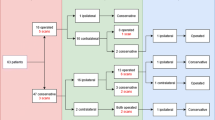Abstract
Background
Spontaneous pneumothorax (SPTX) is a relatively common condition. In patients with SPTX, CT has been advocated to identify blebs and bullae (BB) to help in management planning.
Purpose
The study was designed to assess our experience with CT evaluation for underlying BB in children with SPTX as compared to normal controls.
Materials and methods
Forty-three children (mean age 16 years, range 13–19 years) with 50 SPTX events with both chest radiographs and CT scans were reviewed. CT findings were compared with those seen in 29 age- and gender-matched controls without SPTX. The parameters evaluated included size, number, location, and ipsi-/contralateral BB; apical lines; and surgical correlation.
Results
In the study group, BB were identified in 14 imaged events (28%) (size 2.5–45 mm, one to six BB) with contralateral BB in 11 of the 14 (78.6%). All BB were confined to the apices. BB were sometimes difficult to differentiate from “apical lines”—a suspected normal variant seen in 28 imaged events (56%). Of blebs seen at surgery, 59% were identified on CT, and there were no false-positive CT findings. In the control group, no BB were identified but “apical lines” were seen in eight children (28%).
Conclusion
BB were seen by CT in 28% of imaged events in children with SPTX and were always confined to the apices. When present, BB were commonly bilateral (78.6%). BB should not be confused with “apical lines,” which were not only seen in 56% of imaged events in the SPTX group but also in 28% of the normal controls.






Similar content being viewed by others
References
Warner BW, Bailey WW, Shipley RT (1991) Value of computed tomography of the lung in the management of primary spontaneous pneumothorax. Am J Surg 162:39–42
Choudhary AK, Sellars MEK, Wallis C et al (2005) Primary spontaneous pneumothorax in children: the role of CT in guiding management. Clin Radiol 60:508–511
Mitlehner W, Friedrich M, Dissmann W (1992) Value of computer tomography in the detection of bullae and blebs in patients with primary spontaneous pneumothorax. Respiration 59:221–227
van Belle AF, Lamers RJ, ten Velde GP et al (2001) Diagnostic yield of computed tomography and densitometric measurements of the lung in thoracoscopically defined idiopathic spontaneous pneumothorax. Respir Med 95:292–296
Smit HJ, Wienk MA, Schreurs AJ et al (2000) Do bullae indicate a predisposition to recurrent pneumothorax? Br J Radiol 73:356–359
Desai SR, Wilson AG (2000) The pleura and pleural disorders. In: Armstrong P, Wilson AG, Dee P et al (eds) Imaging of diseases of the chest. Mosby, London, pp 764–765
Tamura M, Ohta Y, Sato H (2003) Thorascopic appearance of bilateral spontaneous pneumothorax. Chest 124:2368–2371
Donahue DM, Cameron DW, Viale G et al (1993) Resection of pulmonary blebs and pleurodesis for spontaneous pneumothorax. Chest 104:1767–1769
Fraser RS, Muller NL, Coleman N et al (1999) Fraser and Paré’s diagnosis of diseases of the chest. Saunders, Philadelphia, pp 504–505
West JB (1971) Distribution of mechanical stress in the lung, a possible factor in localization of pulmonary disease. Lancet 24:839–841
Donnelly LF, Emery KH, Brody AS et al (2001) Minimizing radiation dose for pediatric body applications of single-detector helical CT: strategies at a large children’s hospital. AJR 176:303–306
Brenner DJ (2002) Estimating cancer risks from pediatric CT: going from the qualitative to the quantitative. Pediatr Radiol 4:228–233
Sihoe AD, Yim AP, Lee TW et al (2000) Can CT scanning be used to select patients with unilateral primary spontaneous pneumothorax for bilateral surgery? Chest 118:380–383
Lesur O, Delorme N, Fromaget JM et al (1990) Computed tomography in the etiologic assessment of idiopathic spontaneous pneumothorax. Chest 98:341–347
Author information
Authors and Affiliations
Corresponding author
Rights and permissions
About this article
Cite this article
Guimaraes, C.V.A., Donnelly, L.F. & Warner, B.W. CT findings for blebs and bullae in children with spontaneous pneumothorax and comparison with findings in normal age-matched controls. Pediatr Radiol 37, 879–884 (2007). https://doi.org/10.1007/s00247-007-0537-7
Received:
Revised:
Accepted:
Published:
Issue Date:
DOI: https://doi.org/10.1007/s00247-007-0537-7




